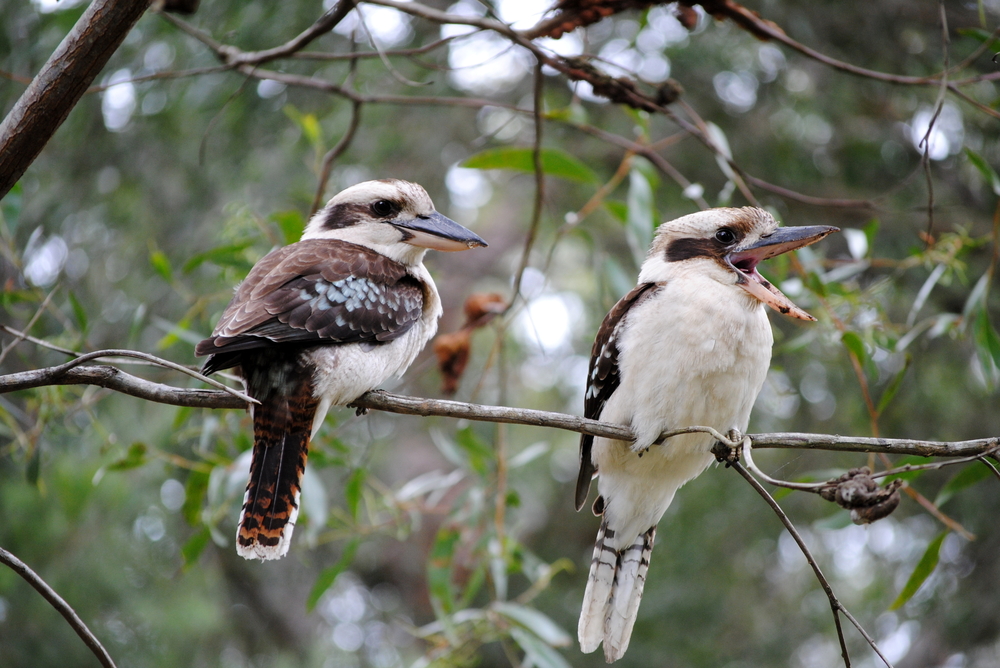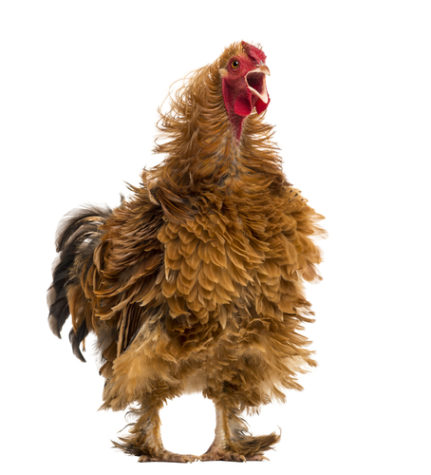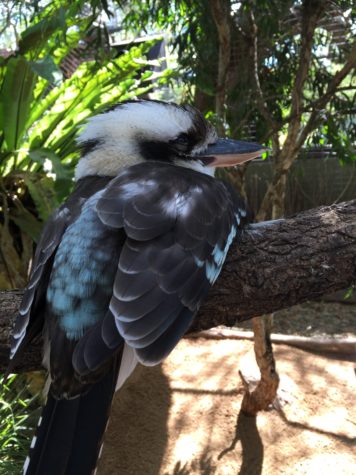 Here’s a post from 2016 that still makes me smile. You, too?
Here’s a post from 2016 that still makes me smile. You, too?
—-
Here comes dawn. The sky yawns and the sun flicks its lids above the horizon. But just before the lights come up on Virginia’s rolling hills, the sound of morning commences. Can we call it a song? That might be a stretch. There’s a certain musicality to it. You’re no doubt familiar with its silly refrain.
Loud and untidy, cock-a-doodle-doo is an enthusiastic drunkard’s karaoke. It’s also a wake-up alarm in much of the rural U.S. If you’re still asleep when this barnyard bird opens its beak, as you should be, you may start dreaming of rooster soup for breakfast. Few of us still have to get up to milk the cows, Cock, and regardless, your rise-and-shine call is awfully brash for a first act.
In parts of Australia, dawn has a very different theme song. Meet the kookaburra, specifically Dacelo novaeguineae. As a visitor, I found it hard to be irritated at the sound of hysterical laughter, even as a 5 a.m. alarm. These stocky, big-beaked birds laugh every day like clockwork around dawn and dusk—plus now and then in between—and they do so as a family. It’s kind of charming: One starts to crack up and then the rest join in, as if just getting the joke.
A not-a-morning-person Aussie may beg to differ on the charm thing. The dawn racket is probably just damn annoying. But as a tourist, I woke up extra early and sat by the window in the dark, waiting for the cackling to begin.
I grew up singing the kookaburra song ad nauseam (did you know it was first a poem, written in 1932? Here’s other info about it). I’m surprised that I never bothered to read up on the birds or to seek out recordings of their calls.
So, mid life, I read and I listened and read some more. Here’s some of what I learned.
This particular kookaburra species is the largest bird in the kingfisher family, native to eastern mainland Australia but introduced to a few other places, including New Guinea, Tasmania, and New Zealand. The kooky call is territorial, with, as mentioned, one bird coughing up the first chuckle before the group hysterics kick in. Loose family groups within calling distance laugh for, or maybe at, each other to mark their space. And kookaburras are carnivorous, plucking up everything from bugs to mice to venomous snakes; in fact, they’ve pissed off lots of farmers because of their acquired taste for poultry. (Take that, tin-eared Rooster.)

They’re also pretty birds, with creamy bellies and heads, a dark stripe from each eye (think Adele), reddish-brown tail feathers, plus brown wings dabbed with blue.
The kookaburras’ calls are what got my attention, but I can’t ignore their fabulously complex social and breeding biology. These birds take family very seriously; as cooperative breeders, kookaburra offspring may become “helpers” who assist in feeding younger siblings to take some pressure off the parents.
But what’s especially curious is that the sex ratio of the offspring depends on the type of social group in that nest—whether there are daughter or son helpers or no helpers at all. Daughter helpers are less helpful, even detrimental (their presence can depress breeding in other females), so a breeding mom might “prefer” more male offspring in her next clutch and can actually affect that number. I don’t know how she does this—whether it has to do with incubation temperature (see also this description) or something else—and so far I haven’t found anyone who knows. It may simply still be a mystery to biologists as well: These authors pointed out in 2002 that in birds, “the mechanisms for primary sex ratio manipulation are unknown.”
Breeding pairs are monogamous, which is sweet, but the hatchlings can be bullies: They often commit siblicide—killing off the weakest in the nest to reduce competition for food and parental attention. They’ve even evolved a special bro/sis-murder weapon, a hook in the upper beak—a rare case of a physical specialization for sibling rivalry. In fact, kookaburras’ whole reproductive strategy facilitates this behavior, as eggs (typically three) hatch asynchronously, putting that last little bird at risk in a nest of older, bigger, stronger siblings.
Evolution was showing off on kookaburra day; this breeding-hatching thing gets even more convoluted. Females grow larger than males, so logically the order of hatching should affect how nest battles go down, with the biggest (strongest) coming out on top. But the whole system is rigged: The first to hatch is predominantly male, giving that bird a leg up on, or at least equal footing with, the second hatchling—usually female. Bird number three’s sex may depend on what else is in the nest from previous clutches. Too many self-absorbed females hanging around? The last egg probably holds a boy. (He might not survive anyway. But just in case, the mother bird will likely choose the sex that’s best for the mix.)
I hate to mention it, but like so many of my favorite creatures, the kookaburra is declining in number, with habitat loss, feral cats, and foxes as culprits.
But for now these funny birds are still common where they live, whooping it up daily, so let’s end on a happy note, shall we? Have another listen to some kooaburras making a fuss over dawn’s arrival, and I’m betting you’ll at least crack a smile.
—–
Top and middle images from Shutterstock; bottom image (sorry for cutting off the tail) by the author, at Lone Pines Koala Sanctuary, Brisbane